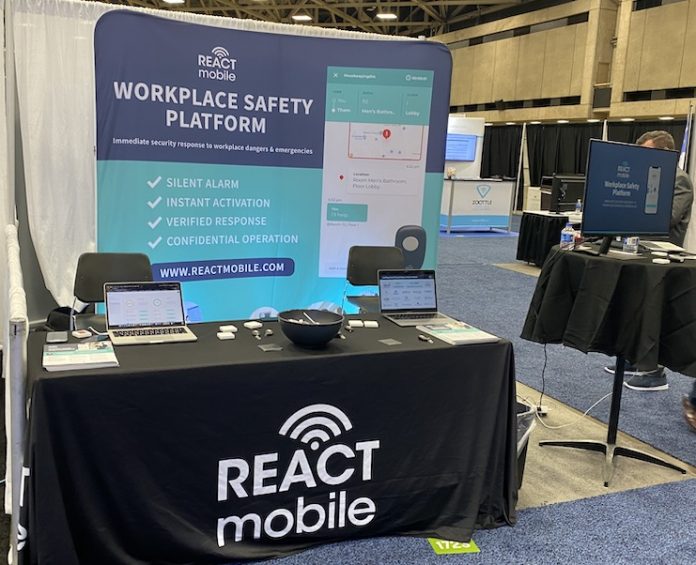While at HITEC Dallas 2021 at the Kay Bailey Hutchinson Convention Center, LODGING had a chance to weigh in with React Mobile’s Interim CEO John Stachowiak and Chief Technology Officer Riley Eller. The two, both of whom came on within the last year, say their hospitality-specific business is booming as a result of growing demand, partly thanks to mandates from unions and state governments and industry-wide pressure to comply with AHLA’s 5 Star Promise, a pledge to provide hotel employees across the United States with employee safety by the end of 2021—a deadline that has since been extended a year. They also described the advantages of their improved system, how and why it was developed, and explain why they believe a silent solution is better than an audible one.
What can you tell us about the development of the product you just introduced at HITEC on Monday, September 27?
Riley Eller (RE): In a nutshell, I officially joined React Mobile in January, but I spent December 2020 going over every feature request and every defect and every alert that’s ever happened in the history of the company. Then I spent the month of January designing a new solution, and February laying in technology plans. We broke March 1 and introduced the product—a revamped silent alarm activation and tracking system—here at HITEC on September 27.
How does this system improve upon the previous one, and why is it silent, not audible?
RE: The React Mobile system is an open and flexible platform that can allow management to deploy response resources to the exact location of an emergency within seconds of an alert, getting help to where it’s needed anywhere on or off property. The thinking behind making it totally silent is that, unlike an audible alarm or interaction with a dispatcher, it doesn’t escalate the problem when a perpetrator hears it.
Previously, customers had to purchase our panic button and infrastructure—our proprietary React Beacons—an option that we still consider our “best” solution, but this single option didn’t meet the needs of all who wished to provide a safety solution for employees. With our new flexible back end, we can use whatever other systems people want us to. Right now, that means push notifications to our applications, to our web console, and SMS email.
How does it work?
RE: When a device activates an alert, it identifies the closest beacon and reports the precise room number location information along with GPS coordinates to our safety platform. This information updates in real-time throughout an alert, providing up-to-the-minute location information. Our platform is designed to work both on and off property. While your employees are on property, we can pull their location information from either an integration with your hospitality management software or from our Bluetooth beacon network to provide room-level accuracy anywhere inside your building. Off property our system can revert to GPS tracking to provide location information anywhere in the world.
How are you marketing the system?
John Stachowiak (JS): Since introducing the more flexible platform, we have begun providing what we call our good, better, or best strategy, as opposed to offering only a single “best” strategy, as before. The “good” approach offers a solution for economy hotels that want to meet minimum requirements for compliance in states that have mandated it. With it, there’s no infrastructure to purchase; our safety platform notifies the response team that there is an alert on property and integrates with the existing housekeeping software to identify the employee’s name and where they were last. The “better solution” enables customers to save 80 percent in upfront capital expense because it uses existing infrastructure, such as the property’s iBeacon type technology, thermostats, and WiFi routers, plus our panic button, which will get responders in close proximity, but not likely within five feet as with the React Beacon and panic button, which remains the the “best” option.
How has business been?
JS: We’ve already signed off budgets for 2022, yet there are interesting things happening at the macro level that bode well for our growth, positive signs reflected in the gratifying response we’re receiving to our current effort to raise capital.
First, Washington state, New Jersey, and Illinois, now mandate panic buttons for all hotels with over 50 rooms, and it’s in the legislature in California and Oregon, with more states expected to follow. The other thing that’s happened in the last couple of years is that the collective bargaining agreement for the union of workers in Las Vegas successfully passed a panic button mandate. We already have 41 percent of all hotels on the strip, plus maybe 20-30 percent of non-union casinos. Then, too, is pressure from the AHLA, which has urged members to comply with its 5-Star Promise, a pledge to provide hotel employees across the United States with employee safety by the end of 2021, something many brands and management companies insist upon despite the one-year extension of the official compliance deadline.
Other opportunities for growth exist in healthcare and education. We’ve seen an uptick in requests for panic buttons for doctors and nurses due to COVID vaccine issues, and, in the case of education, the requests are for panic mounted buttons on classroom walls, with students trained in their use, similar to hotel employees.
[wp-video-popup autoplay=”1″ mute=”1″ video=”https://lodgingmagazine.com/wp-content/uploads/2021/09/SHO-SM-2021-September-HotelApp-1920×1080-Demo.mp4″]










